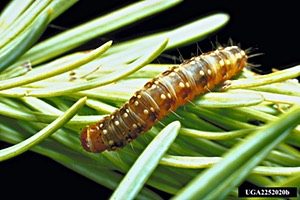 Forty odd years after Elizabeth May launched her campaign against budworm spraying in Cape Breton, and approximately 35 years since the last budworm outbreak petered out, we are again looking for a quick fix to stop or slow the next one.
Forty odd years after Elizabeth May launched her campaign against budworm spraying in Cape Breton, and approximately 35 years since the last budworm outbreak petered out, we are again looking for a quick fix to stop or slow the next one.
From Early intervention research is key by Andre Gunn (Chronicle Herald, Feb 23, 2018):
The Nova Scotia forest industry is hoping Tuesday’s federal budget will contain funding for a program that is attempting to halt the spread of a devastating pest to the province’s woodlands.
…”Wood is scarce enough in Nova Scotia as it is right now and if we have another outbreak, it’s pretty well going to cripple the industry because we’re not going to have enough fibre to run our mills. They wouldn’t survive.”
…Jeff Bishop, executive director of Forest Nova Scotia, said estimates show another outbreak as bad as the one that began in the 1970s could have a $15-billion economic impact in Atlantic Canada.
…That’s why, back in 2014, Forest Nova Scotia joined with a number of other entities in Atlantic Canada like universities, provincial governments, scientists from Natural Resources Canada, logging companies and other groups to create the Healthy Forest Partnership. The goal of the partnership is to better understand the spread of spruce budworm and find a way to contain outbreaks
…By treating the hot spots along the leading edge of the outbreak with aerial application of substances like tebufenozide and bacillus thuringiensis, which are effective against spruce budworm and according to the partnership pose minimal environmental risk, scientists are hoping to slow or stop the spread.
The anticipated outbreak is pretty well on cue (30-40 years between outbreaks), so one might wonder why such planning has not been integral to forest management policies since the end of the last outbreak (1983). There have been advocates of such planning in the past:
“Tothill (1922) suggested that the forests could be made ‘budworm-proof’ for the future. He recognized it ‘would be wholly impracticable were it not for the fact that there is a period of about thirty years in which to bring it about…’”
– Cited in Sandberg and Clancy, Against the Grain UBC Press, 2000.“Two essentials are indicated in forest management to ‘budworm-proof’ the forests. One is to develop mixed forests and reduce fir content especially on the mainland and the lowlands of Cape Breton. The other is to regulate harvesting so as to develop a broken distribution of age classes of softwoods and particularly in the fir forest of the Cape Breton Highlands. The rigid utilization of fir within its biological rotation age is essential but not at the expense of longer-rotation red spruce.”
– Lloyd Hawboldt, NS Dept. of Lands and Forests, 1976.
(Cited in Sandberg and Clancy, Against the Grain UBC Press, 2000.)
Of course it’s too late for such planning now, so once again we grab the pesticides to stop or slow down the outbreak of a native (non-exotic), highly predictable pest that we could have begun preparing for with appropriate forest management even close to a century ago.
Meanwhile the climate is changing and it’s pretty close to certain that both black spruce and balsam fir don’t have much future in this province. What is our Early Intervention Strategy for dealing with climate change in our forests?
——–
Addendum: In the news: Spruce budworm funding welcomed as push to keep species out of Nova Scotia continues
Andrea Gunn, Feb 27, 2018.
